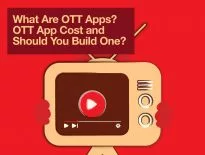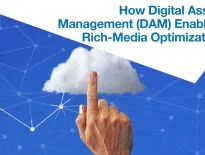
New technologies allow content creators to meet surging demand for over-the-top content with minimal investment and only a few weeks’ time.
Demand for over-the-top (OTT) streaming services is surging, and experts don’t think there’s an end in sight.
The global pandemic has revitalized streaming engagement across every level of society. Unlike many other pandemic-fueled economic booms, this doesn’t appear to be a one-time boost. People are relying on their streaming providers more than ever, and reopening economies are well-poised to capitalize on that fact.
OTT viewership is likely to remain strong as sports, concerts, and other live events re-enter the broadcasting arena. For many content creators, this is a unique opportunity to establish a dominant position in a dynamic new industry.
Use New Technology to Overcome OTT Challenges
If your brand is already creating high-quality content, you’re already halfway there. Managing, formatting, and publishing that content is the primary challenge that prevented brands from capitalizing on the OTT market.

Content owners who incorporate OTT platforms into their business models can overcome these challenges and create valuable digital experiences for viewers all around the world.
1. Format Content for Every Device
Unlike traditional cable television, OTT media is fully responsive. It has to display correctly on a wide variety of devices, from mobile devices to gaming consoles and web browsers. This makes the hardware environment a uniquely challenging place for content creators.
Until recently, content owners needed to hire device-specific engineers for every format they wished to broadcast in. Managing and programming content was incredibly expensive, which made it impossible for small businesses to compete with multi-billion dollar media corporations.
Now, you can build your own OTT service and deploy content management systems that automate this process. Solutions like 24i enable content owners to implement fully responsive content across the entire device spectrum without writing any code whatsoever.
This approach allows content owners to treat their OTT business like a TV channel. The giants of yesterday’s traditional media landscape were able to outsource infrastructure and focus on content – now you can too.
2. Optimize Video Monetization
OTT monetization models are slightly different than the ones traditional TV channels use. There are many different ways to monetize video content. You don’t necessarily have to charge a subscription the way services like Netflix do. But you do have to align the type of content you create with the monetization opportunities available.

OTT video monetization through advertising requires three things:
- An audience. In most cases, OTT advertisers pay on a cost per mille Once you have an audience that numbers in the thousands, you can start generating cash flow.
- Audience engagement data. OTT content owners have far greater access to audience data than traditional advertisers do. You can go beyond demographics and look at how individual users interact with specific video content.
- OTT advertising technology. Every OTT video platform relies on software infrastructure to generate income. This can be as simple as using Google Ads, or it can be a custom OTT publishing solution like Verizon Media Smartplay.
Once you have these three things in place, you can start monetizing OTT video content through advertising. This will allow you to sustainably create free content for users and begin promoting it on social media and other streaming services.
3. Coordinate and Manage Media Assets Effectively
If you are trying to build your own OTT service around video content to display on smart TVs, you will need a high-performance solution for managing video content effectively. This is a job that requires an OTT-oriented digital asset management (DAM) platform.
DAM platforms enable content owners to store, manage, and edit different types of content from a single point of reference. This is critically important for organizations that need to display and monetize content across multiple channels.
Without a DAM in place, you will eventually end up spending hours searching for the latest version of frequently edited content. Personalizing content to meet viewer expectations will not be possible. You won’t be able to use viewer analytics to power modern monetization models.
A fully featured DAM solution will play a vital role helping you curate and manage your content for viewers. This will help you maximize the value of the time you spend creating and distributing content, while ensuring your media partners are always able to access the data they need.
4. End-to-End OTT Integration
Early OTT successes had to build their own media infrastructure from scratch. This is no longer necessary. Content creators can now distribute their content to a whole world of OTT devices through partnership with an end-to-end OTT provider like Cincopa or Verizon.

This approach allows content creators to focus on what they do best – making high-quality content that viewers love. On the technical and infrastructural side, your end-to-end integrator does the job of coordinating live, linear, and event channels into your OTT solution.
You can control the ingestion of enriched metadata to supplement video content without having to create your own indexing solution for the purpose. Personalized content, highly customizable user management, and user experience development is possible through end-to-end OTT integration with a reputable partner.
Content creators need to go beyond great content and establish a competitive environment for their content to thrive in. And end-to-end provider ensures that the video content experience is engaging across every device, enabling OTT content creators to build audiences and strengthen viewer loyalty.
5. Put User Convenience First
OTT consumers value convenience above all else. They expect consuming video to be an easy, intuitive experience, regardless of the device they choose to use. Service providers and content creators are under pressure to deliver attractive, easy-to-use applications on multiple devices, while promoting their content libraries in a standardized way.
The Smart OTT approach makes this possible. Content creators do not have to create an entire video application development platform for every device from scratch. It’s possible to leverage a single software provider to achieve intuitive, consistent user experiences across all OTT-compatible hardware.
Turnkey video application development allows content creators to use an advanced cross-screen development framework and modular architecture without having to compromise the user experience in the process. That means there is no need to an army of in-house developers to ensure your OTT content has a consistent user interface across platforms and devices.
6. Automate DRM Security
Your OTT content will only be able to deliver results if viewers log onto your platform in order to consume it. If they can easily download, share, or manipulate your content without crediting its creators, you may find yourself losing valuable advertising profits even though your content is more popular than ever.

Digital rights management is an extremely important part of any OTT video business model. Content owners must be proactive when it comes to protecting licensed content from unauthorized use.
There are multiple technologies OTT content creators can use to protect their rights:
- Forensive watermarks embed small bits of code directly into media files. Human beings cannot perceive these watermarks, but watermark detector software can. Every genuine copy of the content has a unique code embedded, which means that pirated copies can be traced back to an original source.
- Paywall integration allows content creators to charge subscription costs directly to content consumers. Reputable paywall vendors allow for multiple types of integration, including subscription video on-demand, ad-based monetization, and pay-per-view streaming.
- Geographic and platform restrictions can prevent certain individuals from consuming content entirely. This can be useful for preventing non-authorized users from accessing sensitive data. For example, a content creator who focuses on local OTT content may restrict viewers from other countries, by simply virtue of the fact that there is no legitimate value for far-off users to access that data.
7. Embed APIs for Programmatic Access
APIs are a critical tool for creating your own OTT platform. These software tools ensure smooth performance across your entire tech stack. They act as interfaces between multiple software applications, making it possible for these applications to execute requests from one another without manual intervention.

Every third-party software application you use to create, edit, and distribute OTT video content to users can benefit from programmatic access to the rest of your stack. This allows your team to avoid constantly moving from one application to another, completing painstaking manual tasks repetitively in order to generate value.
Using APIs to connect your DAM platform to the rest of your OTT environment makes it possible for your team to deploy customized video streaming solutions to partners and vendors. In turn, this enables third parties to use automation to generate value from your content while serving your audience at the same time.
Implement World-Class OTT Infrastructure Now
Building a successful OTT enterprise is more accessible now than it has ever been before. Content creators can now leverage sophisticated tools that give them a competitive advantage against established content services like Netflix. The right combination of technologies can help you produce, distribute, and live stream high-quality content to a wide range of devices with minimal overhead costs.









